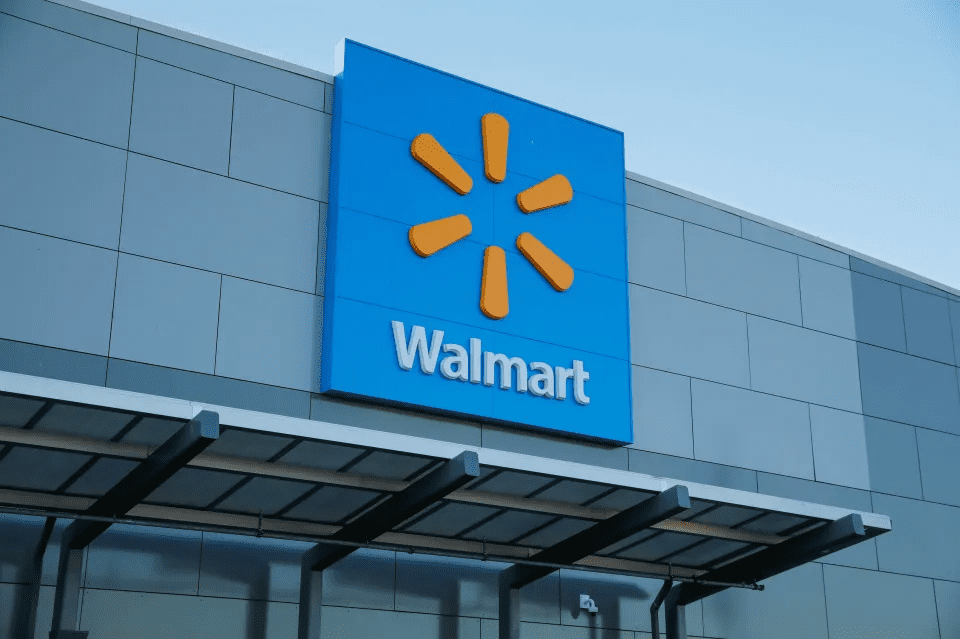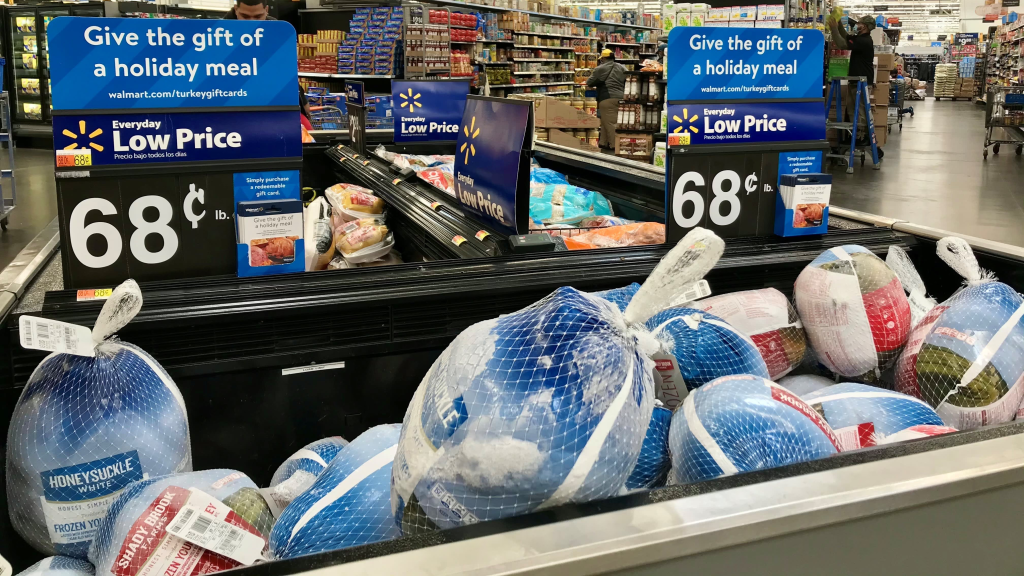Walmart CEO Announces Thanksgiving Turkeys at 68¢ a Pound — Lowest Price in 6 Years as Trump’s Economic Shift Sparks Consumer Wins
In a stunning pre-holiday announcement, Walmart CEO Doug McMillon revealed that the price of Thanksgiving turkeys will hit their lowest level since 2019 — a headline that’s sending both shoppers and economists into a frenzy. After years of painful grocery inflation, supply-chain chaos, and rising fuel costs, the nation’s largest retailer has finally delivered a piece of good news for the American dinner table: this year, families can expect to pay just 68 cents per pound for their Thanksgiving bird.

For many households, that figure isn’t just a statistic — it’s a small but powerful symbol of relief. The average American family saw grocery costs soar nearly 25 percent between 2020 and 2023, driven by pandemic disruptions and energy spikes. But the 2025 holiday season marks a turning point. Walmart’s data shows wholesale poultry prices falling sharply due to improved supply chains, reduced feed costs, and stronger consumer demand planning. According to the U.S. Department of Agriculture, frozen turkey inventories reached record highs this fall, helping drive down prices across the board.
McMillon described the rollback as part of Walmart’s mission to “give families breathing room” as holiday shopping ramps up. “We know how important Thanksgiving is to Americans,” he said in a statement shared with Fox Business. “Our teams have worked hard to keep prices low, and for the first time since 2019, a full holiday meal will cost less than last year.”
For everyday shoppers, that’s not corporate spin — it’s real savings. The American Farm Bureau Federation, which tracks Thanksgiving dinner costs each year, reported that a typical feast for 10 people will average $61.12 in 2025, down 5 percent from 2024 and 10 percent from the record highs of 2022. It’s the second consecutive year of decline, signaling what economists describe as “food deflation momentum.”

But there’s a political undercurrent to the celebration. The news came just weeks after Donald Trump’s economic messaging dominated the post-election narrative, with renewed focus on affordability, supply-side growth, and domestic production. Conservative commentators wasted no time linking Walmart’s move to the broader optimism surrounding Trump-era policies returning to prominence. Posts across X (formerly Twitter) lit up with comments like “I voted for this!” and “This is what winning feels like.”
While the correlation isn’t direct, the sentiment is telling. Under Trump’s economic vision — revived through campaign discussions about deregulation, domestic energy, and manufacturing — consumer confidence has spiked among key retail demographics. According to the Conference Board, the Consumer Confidence Index rose 8 points in October 2025, its highest level in two years. Analysts credit falling fuel prices, easing freight costs, and tighter inventory control as contributors to the turkey price drop, but also acknowledge the psychological factor: optimism is contagious, and Americans are spending smarter again.
Inside Walmart’s Bentonville headquarters, executives say the strategy reflects both logistics mastery and customer trust. The company secured long-term supplier contracts earlier this year, anticipating that feed and fuel costs would decline as global shipping normalized. Walmart has invested heavily in data analytics and domestic sourcing to avoid the shortages and price volatility that defined pandemic-era markets. “We learned hard lessons in 2021 and 2022,” McMillon said. “This year, we wanted predictability — and we achieved it.”

Economists note that the announcement signals something larger than just Thanksgiving dinner. Food inflation, once a political lightning rod, appears to be stabilizing. Federal Reserve data shows grocery inflation down to 1.8 percent year-over-year — the lowest rate since before COVID-19. Poultry, eggs, and dairy led the decline, thanks in part to strong domestic production and favorable weather for feed crops in the Midwest. When combined with lower gas prices — now averaging $2.83 per gallon nationally — the average American household is saving an estimated $120 a month compared to late 2023.
Walmart’s decision to publicize the 68-cent turkey price is also a marketing masterstroke. It positions the company as a hero for middle-class families just weeks before the biggest shopping season of the year. The company expects record Black Friday traffic and early surge buying as consumers respond positively to what they see as tangible economic relief. “It’s psychological as much as practical,” retail analyst Burt Flickinger told Bloomberg. “When Walmart tells America Thanksgiving will cost less, people believe things are getting better — and that confidence is powerful.”

Of course, not everyone agrees on the causes. Critics argue that short-term price dips don’t erase years of inflationary strain. The Bureau of Labor Statistics still records cumulative food-at-home prices roughly 20 percent higher than pre-pandemic levels. But others counter that what matters most is trajectory — and for the first time in half a decade, the curve is bending back toward affordability.
That sense of relief is palpable across social media. Videos of shoppers celebrating “old-school prices” have gone viral, while Walmart’s Thanksgiving ad campaign — titled Grateful Together — leans heavily into nostalgia and gratitude. With an upbeat country soundtrack and images of families gathered around perfectly roasted turkeys, it’s designed to tap into a renewed faith in stability.

Political strategists are watching closely. In a polarized nation, even grocery prices can become a proxy for broader ideological battles. Republicans see Walmart’s announcement as validation that pro-growth, low-regulation policies work. Democrats, meanwhile, note that broader macroeconomic recovery trends began under bipartisan fiscal management. But among everyday Americans, the takeaway is simpler: food costs are finally falling, and that’s reason enough to celebrate.
The timing couldn’t be better for Walmart. Its Q3 earnings report showed a 6 percent revenue jump driven by grocery sales and expanded delivery services. Analysts say affordability moves like the Thanksgiving turkey rollback will further cement Walmart’s dominance over competitors such as Kroger, Target, and Amazon Fresh. “It’s smart economics,” said retail strategist Stephanie Pomeroy. “You build loyalty when people feel you’re on their side.”
Beyond economics, though, this story carries a deeper emotional weight. Thanksgiving has always represented gratitude, tradition, and unity — values that resonate even more in turbulent times. The return of affordable family dinners feels like a small restoration of normalcy after years of uncertainty. For millions of Americans, the news isn’t just about saving a few dollars — it’s about feeling hopeful again.
McMillon acknowledged that emotional connection directly. “When families gather this November, they deserve to focus on what matters — not what they can’t afford,” he said. “We’re proud to play a part in making that happen.”
As shoppers flood stores in the coming weeks, Walmart’s move will likely ripple across the retail sector. Competing chains are expected to match or undercut turkey prices to capture market share, setting off what some analysts call a “holiday price war.” For consumers, that’s the best kind of fight — one where everyone wins.
And for many voters who spent the past few years watching grocery bills climb higher each month, this moment feels vindicating. It’s a tangible reflection of the optimism returning to America’s economy — a small victory that speaks volumes. As one shopper told a local reporter in Dallas, “I don’t know about politics, but I know my wallet — and this feels like the first Thanksgiving in years I don’t have to stress.”
From a 68-cent turkey to a restored sense of confidence, this Thanksgiving may be remembered not just for full tables but for full hearts — a reminder that progress, even in small bites, still matters.


